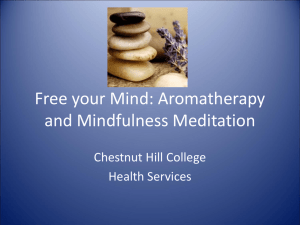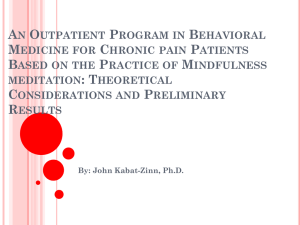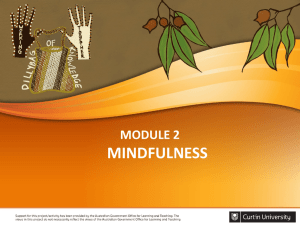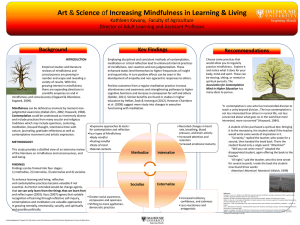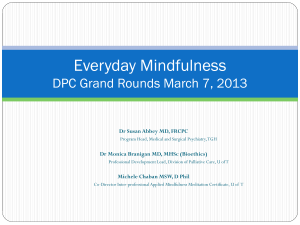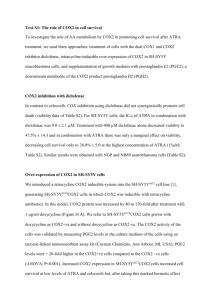Rapid changes in histone deacetylases and inflammatory gene
advertisement
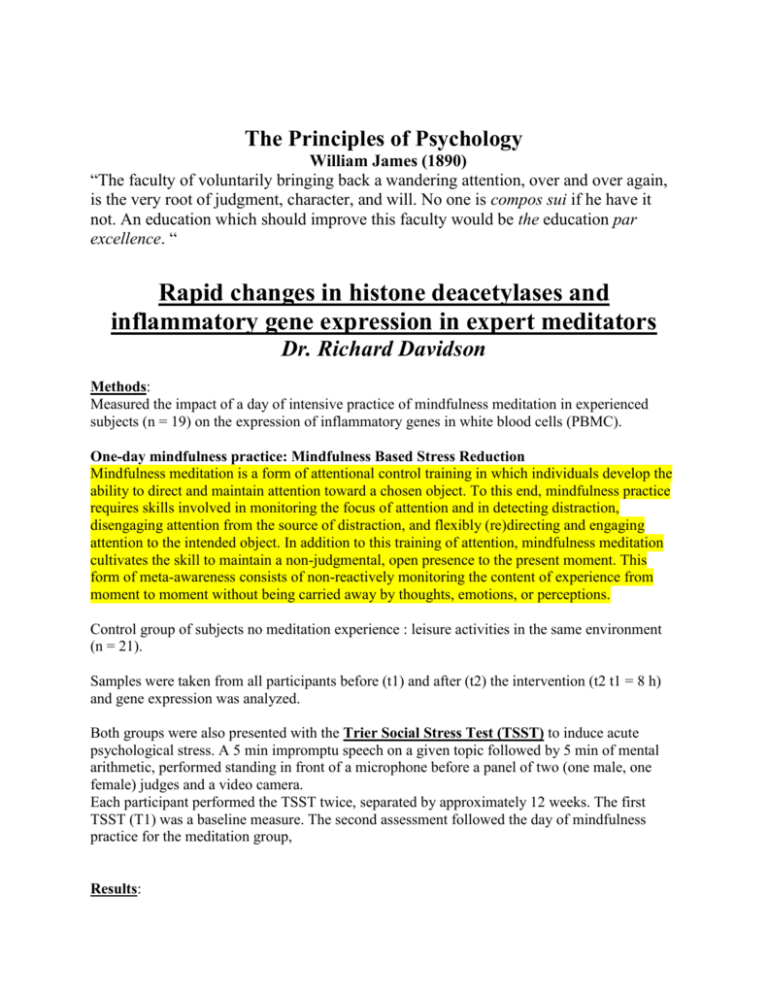
The Principles of Psychology William James (1890) “The faculty of voluntarily bringing back a wandering attention, over and over again, is the very root of judgment, character, and will. No one is compos sui if he have it not. An education which should improve this faculty would be the education par excellence. “ Rapid changes in histone deacetylases and inflammatory gene expression in expert meditators Dr. Richard Davidson Methods: Measured the impact of a day of intensive practice of mindfulness meditation in experienced subjects (n = 19) on the expression of inflammatory genes in white blood cells (PBMC). One-day mindfulness practice: Mindfulness Based Stress Reduction Mindfulness meditation is a form of attentional control training in which individuals develop the ability to direct and maintain attention toward a chosen object. To this end, mindfulness practice requires skills involved in monitoring the focus of attention and in detecting distraction, disengaging attention from the source of distraction, and flexibly (re)directing and engaging attention to the intended object. In addition to this training of attention, mindfulness meditation cultivates the skill to maintain a non-judgmental, open presence to the present moment. This form of meta-awareness consists of non-reactively monitoring the content of experience from moment to moment without being carried away by thoughts, emotions, or perceptions. Control group of subjects no meditation experience : leisure activities in the same environment (n = 21). Samples were taken from all participants before (t1) and after (t2) the intervention (t2 t1 = 8 h) and gene expression was analyzed. Both groups were also presented with the Trier Social Stress Test (TSST) to induce acute psychological stress. A 5 min impromptu speech on a given topic followed by 5 min of mental arithmetic, performed standing in front of a microphone before a panel of two (one male, one female) judges and a video camera. Each participant performed the TSST twice, separated by approximately 12 weeks. The first TSST (T1) was a baseline measure. The second assessment followed the day of mindfulness practice for the meditation group, Results: All the epigenetic regulatory enzymes and inflammatory genes analyzed exhibited similar basal expression levels in the two groups. (t1) After the brief intervention we detected the following changes in in meditators compared with controls: 1. reduced expression of histone deacetylase genes (HDAC 2, 3 and 9) 2. alterations in global modification of histones (H4ac; H3K4me3) 3. decreased expression of pro-inflammatory genes (RIPK2 and COX2) 4. found that the expression of RIPK2 and HDAC2 genes was associated with a faster stress- evoked cortisol recovery to the TSST in both groups. Histone deacetylases (HDAC) are a class of enzymes that remove acetyl groups from amino acids on a histone, allowing the histones to wrap the DNA more tightly. This is important because DNA is wrapped around histones, and DNA expression is turned OFF by de-acetylation. WHY? 1. HDACs remove acetyl groups from different histone or non-histone residues and after the intervention, the meditation group showed a decrease in the gene expression of histone deacetylases HDAC2 compared to controls. HDAC2 are epigenetic chromatin modification enzymes—which allow DNA to wind more tightly @ Histones. HDACs modulate inflammatory pathways – 2. After the intervention, we found a significant down regulation in the mindfulness meditation group of RIPK2 & COX2 genes, which are pivotal enzyme regulators of inflammatory processes So less expression of HDAC2 means what?? The down regulation of HDAC gene expression in the meditation group was accompanied by reduced expression of pro- inflammatory genes RIPK2 & COX2. 3. Activation of proinflammatory signaling in white blood cells has been described as an effector for the neuroendocrine response to psychosocial stress We therefore analyzed the recovery of cortisol levels following the TSST (stress test) in both groups of participants at study entry (T1) and approximately 12 weeks later (T2) and its correlation with HDACs, RIPK2 and COX2 gene expression. For the meditation group, T2 corresponds to the day following mindfulness practice. In both groups of participants, a better cortisol recovery was associated with lower postintervention levels of RIPK2 and HDAC2 So, the less pro- inflammatory genes RIPK2 and HDAC2 are active, the quicker the cortisol recovery following stress.

